Back with another ukulele review, and an instrument that has actually been around for a little while now - the iUke Piccolo mini ukulele.
A little while ago I reviewed another piccolo uke (the John Daniel Pixie) and in that made reference to the iUke and the fact that I didn't really like it that much. That was based on me having played a couple briefly at uke festivals and nothing more. The UK distributor, Stones Music, got in touch and (rightly) suggested that I actually test one for a while and write up a fuller review. So here we go.
The iUke is a solid topped piccolo or sopranino scale instrument developed by iUke in conjunction with Aquila strings. It is a solid topped instrument and designed primarily for beginners on account of the fact that it is designed to be tuned to standard GCEA tuning but one whole octave above a soprano uke. The strings were developed specifically for the uke to allow this tuning to work, but this was actually one of the things I didn't like about it.
The ukulele retails at around £79 in the UK which is pretty terrific value for any instrument, particularly one with a solid wood top like this one has. This one has a solid cedar top and hardwood laminate back and sides, and is in a pineapple shape and plain finish. They are also available in traditional figure of eight shape and with different top finishes.
Looking at the build at this one, it really is nicely put together. The grain on the solid top is simple, but nicely lined up with the top of the uke, and the laminate sides too are nicely lined up. The sides are, incidentally, a single piece of wood with no join at the base.
The bridge is a rosewood slotted style for easy re-stringing and it appears to be screwed to the top of the uke. Looking inside, all is nice and tidy, with fairly minimal bracing on account of the size of the uke (in fact, I think there is just a single brace on the top and nothing on the back on account of the extra strength in laminate. Kerfing is un-notched but well applied, and the makers label shows both the Aquila and iUke logos, and the fact it is made in China. The label actually says 'Mini Uke' not Piccolo, but there you go, its still a piccolo.
The edges of the body are unbound, and that means you see the uke top and back in section, with the top clearly showing off the solid wood. The back though shows off the laminate and looks a little scruffy and I wonder if binding would have been a nice addition. The whole body is finished in satin.
Moving on to the hardwood neck, this is made from three pieces with a joint at the heel and one halfway down the neck which is unusual. For such a small instrument I would have thought it would be easy to shape this out of a single neck block, but presume this is cost saving. The profile and finish on the neck is very nice though.
The fingerboard is also very nicely finished and impressed me. Its topped with rosewood which is uniform and dark in colour. The edges of the fingerboard are not bound, but stained so you can hardly see the fret edges. Best of all, the edges of the fingerboard are rolled / shaped meaning you feel no hard edges which is a really nice touch. The frets too, all 12 of them in nickel silver, are really nicely finished with no sharp edges.
Fret position markers are provided on the fingerboard at five, seven and ten in pearloid inlays, but no markers are provided for the player. Perhaps not essential for a very short scale instrument, but it really wouldn't have been a big deal to add one or two.
My first gripe with the instrument comes with the width of the nut which I find VERY narrow. Sure, I get that it is naturally a small instrument, but it is at least 3mm narrower than my John Daniel Piccolo of the same scale. This means a cramped playing area that could easily have been resolved by making that neck a touch wider for virtually no extra cost. As an instrument aimed at the beginner (mainly) I found this a surprise.
Up to the headstock and we have a nice unique design for the iUke with friction pegs fitted in a diamond configuration which I like a lot. The headstock is not faced, but finished in satin and the iUke logo is etched into the wood on an angle.
Those tuners are really cheap though, yet they do the job, even with a fair amount of tension on those strings. The washers though are cardboard, and I found that having set the uke down for a day or two, when adjusting tuning they kind of stick on the first turn and need loosening a touch. Still, when tuned these are holding just fine and you could upgrade them easily.
And that is about it, bar the specific iUke Aquila strings and a rather nice padded gig bag with an embroidered iUke logo. Not a bad bundle for £79.
What about playability? Well, the uke is light and, naturally very small. I found it easy enough to hold though new players may find it a bit of a fiddle. That is hardly a complaint though as the size is what it is. It's balanced though, and the neck feels good in the hand.
Playing though, that narrow neck does present issues to me with lack of space (though I do have big hands). Some may say that is the challenge of piccolo ukes, but others I have played, including both the John Daniel and the Ohana just felt more natural.
It is loud enough when strummed below fret five, but beyond that it gets so shrill and the sustain goes too. This though is perhaps more a feature of the tuning it has been designed for and more on that now.
I totally GET the thinking behind keeping it GCEA, as that allows beginners to jump to it from a standard soprano with ease as the chord shapes are the same. This too allows a club player to immediately join in with others without transposing at all. What I find though is that the soprano naturally high pitched and shrill enough (especially where several are playing together) and to take that up one more octave again just starts getting into irritating territory for me on sound. However... strings are there to be changed, and I would be really interested to try some standard Piccolo strings on the iUke to try to find a lower tuning that suited the build. Ukes tend to have a natural sweet spot on tuning and I found that on my John Daniel with CFAD tuning which really gave it a nice balance and richer tone. I see no reason why that cannot work on this as otherwise the uke is built well. As such, I am not going to run scores down on this review for the fact it is tuned GCEA as that can be changed. As for the concept of learning to transpose - its really not that hard, and you would need to do it with a Baritone too. Remember, in doing so, the chord shapes remain the same just the chords they play will differ. I would certainly recommend anyone buying one of these tries that.
At GCEA though, I think this is just too shrill for my ears. The build though is good and the price extremely attractive and am happy to say that my original views have been changed a little.
Available to buy here! Amazon.co.uk via Omega Music
As usual, here is a video review, and below that the PROs CONs and the scores.
VIDEO REVIEW
PROS
Price
Build quality
Neck finish
CONS
Neck width
Cheap tuners
Anything but high GCEA, please!!
SCORES
Looks - 8
Fit and Finish - 7.5
Sound - 7 (assuming a string change!)
Value For Money - 9
OVERALL - 7.9 out of 10

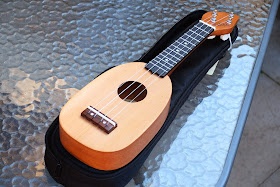

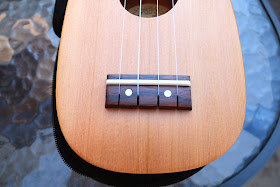
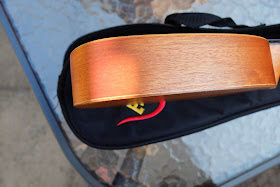

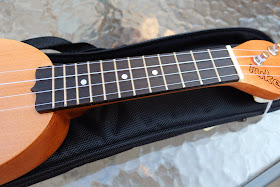

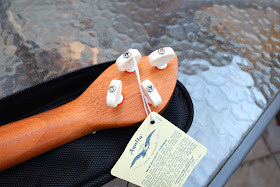

I agree with the tone- made my tinnitus squeal a bit more. My favorite quote, "binding doesn't make any noise". Cute, but not biting on this one. David Remiger aka Ukester Brown
ReplyDeleteYou could probably take a 'C' string from a soprano (C4) and tune it for D4 on the iuke. 'E' could be a G4, then 'A' a B4, and leave the existing E5 string. This would give you guitar/baritone Luke tuning, but one octave higher. I bet that would improve the sound, and it would give it a larger range.
ReplyDeleteWhat is the actual nut width?
ReplyDelete30mm
Delete